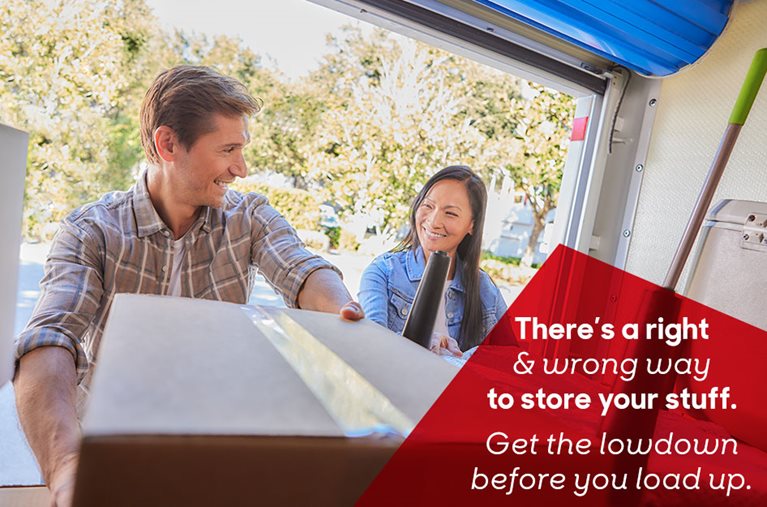
18 Dos and Don’ts for Packing Portable Storage Containers
Storage Tips and Hacks Moving and Storage Container Guides
Whether you’re spring cleaning or moving apartments, you’re going to be reminded about just how much stuff you own. Accumulating furniture, clothing, and various odds and ends that somehow simultaneously have no place and you can’t part with is one of the great conundrums of the human experience. But gloriously, that’s why portable storage containers exist, right? And better yet, that’s why we’ve made this guide for how to pack a PODS container to take all the guesswork out of the process.
Whether you’re moving and need a temporary or long-term place to stash your things, PODS offers a variety of storage options to fit any situation. Want to store things close by for easy access? Keep your container right in your driveway. Need things out of the way for a while? Keep your container in a secure PODS Storage Center. Looking for storage that moves with you? Check that off the list, too! Whatever your storage needs, PODS has you covered.
All you need to know are a few tips for packing a PODS container: basics about what the PODS prohibited items are, what can go in the containers, and how to get the most out of them. So without further ado, here are 18 dos and don’ts for using portable storage containers.
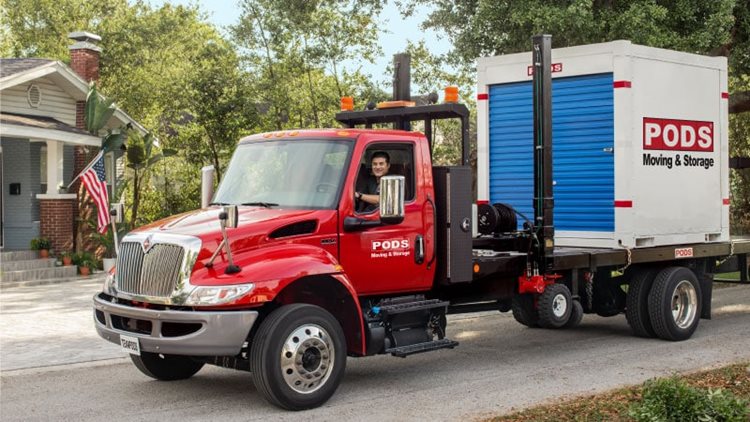
Take the time to figure out which container size will work best for your specific situation.
1. Do Plan Ahead.
Whether it’s making use of clever packing hacks for moving or reserving your portable storage containers at the right time, it’s important to have a plan in place before you start. When you take the time to consider potential problems, you might be able to avoid them altogether. Of course, as with any move, problems are inevitable. Planning for those potential pitfalls can make dealing with them easier, as well.
2. Don’t Go In Blind.
3. Do Get an Appropriately Sized Container.
Choosing a storage unit is a real Goldilocks situation: Pick the one that is just the right size. While it may be tempting to save some money, using a container that’s too small will ultimately lead to frustration — either trying to squeeze your belongings in or having to size up in the end. Similarly, going for one that’s unnecessarily spacious is money you don’t need to spend, and extra space can actually make it harder to keep your breakables safe and secure in a portable storage container.
4. Don’t Have Your Container Delivered Just Anywhere.
When having a PODS container delivered to you, be sure to speak with the driver before or upon arrival, so you know where they can place it (newly paved driveways or uneven surfaces are a no-go) and can decide which direction you’d like the door facing. Communicating with them ensures the container isn’t left blocking your car from the garage or inconveniently stationed too far from the door you’ll be bringing items out of — or any other unfortunate scenario.
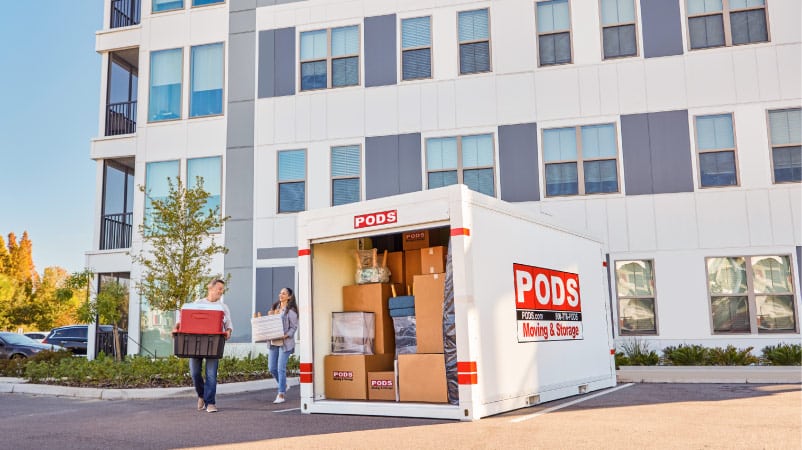
Try to pick a sunny day for loading up your portable storage containers. Moisture that collects on the outside of your packages can seep through boxes and lead to mildew or rot later. No thanks!
5. Do Communicate With Your Building Management.
If you live in an apartment complex, save yourself a headache by giving your landlord or management company a heads up that you’ll be using a storage unit. Whether someone has to let the driver onto the premises or you need permission to leave your portable storage containers in a particular place, you’ll want to make sure both you and your building management have the discussion before the container arrives.
6. Don’t Load Items While It’s Raining.
No one wants to move in the rain, and when it comes to how to pack a PODS container to store things away for weeks or months on end, you really don’t want to. Moisture that collects on the outside of your packages can seep through boxes and lead to mildew or rot — the last thing you want to find when you eventually pull things out of storage.
7. Do Put the Heaviest Boxes on the Bottom.
This is packing 101 but still important to remember! Think of how to pack a PODS storage container like bagging groceries: You don’t want bread or eggs on the bottom of the bag, the same way you don’t want fragile goods or breakables below heavy book boxes or pieces of furniture. Not only does packing a unit from most to least dense save your teacups from turning into powder, but it also helps you to take the best advantage of the space. Also, when deciding where to put what in portable storage containers, try to strategically place the items you need the least access to at the rear. That way, if you need to grab something from storage but don’t want to dig through everything, the things you’re most likely to need are easily found.
8. Don’t Put All the Heavy Things on One Side.
Along the same weight distribution lines, the best way to pack a PODS container is to stack heavy items in layers, not sections, meaning the weight is spread relatively evenly throughout the container. That way, when the container is picked up and relocated to your new home or a storage facility, all the heavy boxes at the back are unable to shift and smoosh all the lightweight boxes at the front.
9. Do Secure Your Belongings.
Another well-known but important tip when considering how to pack a PODS container: Secure your belongings! Wrap your breakables in bubble cushioning roll before loading them into boxes, and employ loading straps, bungee cords, and furniture pads to keep the larger items protected and firmly in place when portable storage containers are on the move.
| Did you know? All PODS moving and storage containers are equipped with hooks to help you secure your belongings. The best part? They’re located throughout the container, so you can decide the best way to strap everything down. |
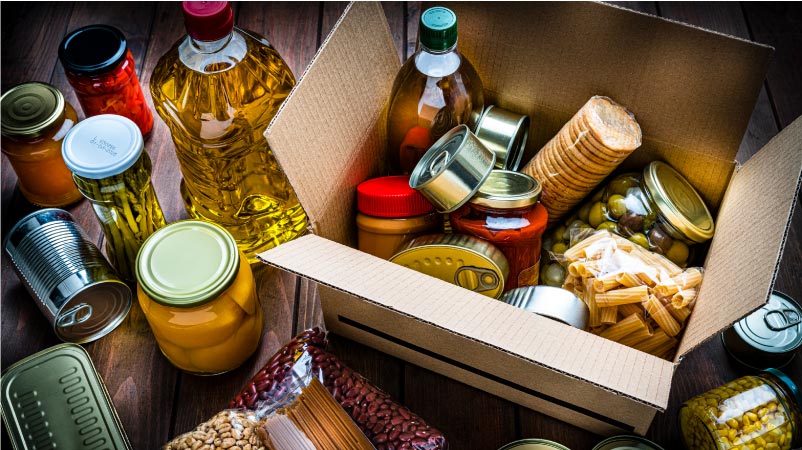
Check your boxes twice for any perishables or plants — you definitely don’t want to put those in your storage container.
10. Don't Store Perishables.
Don’t forget your lunch in your storage container! We kid, we kid. But seriously. Can you think of anything less pleasing than opening the door to the smell of rotten food? Even for canned goods or other shelf-stable products that last for a long time, you’re better off using or donating them than storing them. Also, don’t leave any plants or other living things in the container — they're not known to do well without sunlight or water.
11. Do Keep Important Papers and Irreplaceable Heirlooms With You at Home.
Are PODS containers safe for moving? Yes, if handled and maintained properly. But while papers and family heirlooms you’re not quite sure what to do with may seem like the perfect items to store away, you’re better off keeping them with you. Some pieces, like vintage works of art, don’t fare well in certain conditions. The same goes for highly valuable and irreplaceable keepsakes — keeping them in a place where they may be vulnerable to damage just isn’t worth the risk. Instead, find a place to display them at home or pass them on to another family member who will have more use for them.
| Looking for more pro tips from the storage experts? We were lucky to participate in a Q&A panel of storage experts over on MovingWaldo.com. You'll find answers to questions on securing your things in storage, the minimum time to rent a container, and more. |
12. Don't Use Storage As Your Trash Bin.
At the tail end of a decluttering effort, you may lose steam and want to just bag everything up and throw it in the closet. But what good would that really do? Though portable storage containers are incredibly useful for both short-term storage and long-term storage, be wary of using them as a catch-all closet where you stash things that you could actually just toss, gift, or donate.
13. Do Get a Climate-Controlled Storage Unit for Certain Items.
If you’re storing your rare book collection or beloved comic books, you’ll want to opt for temperature-controlled storage. Do PODS containers get hot inside? Sure, if it’s hot outside. But temperature-controlled storage facilities ensure the unit never gets too hot or too cold, regardless of the weather outside. If you’re stashing vinyl records, musical instruments, wooden or upholstered furnishings, photographs, artwork (like mentioned earlier), antique goods, or any other items that would respond adversely to extreme temperatures or humidity, climate-controlled storage is the move.
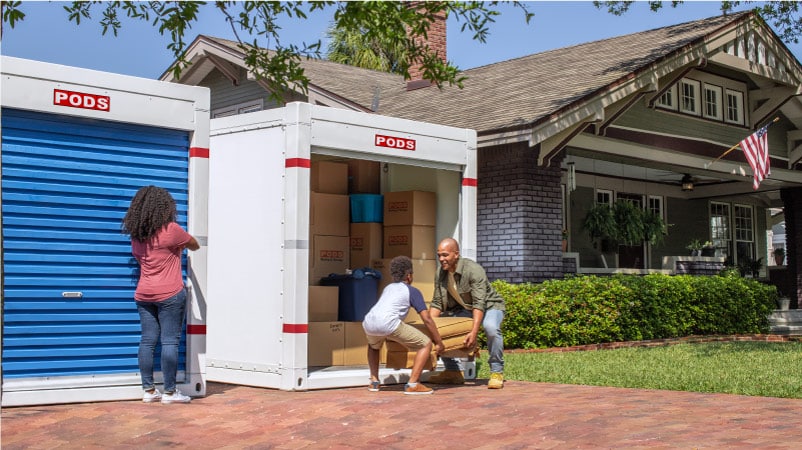
PODS storage containers are designed to be weather-resistant, but if you’re storing anything sensitive to extreme temperatures, you may want to opt for climate-controlled storage.
14. Don't Get a Climate-Controlled Storage Unit If You Don't Need One.
Likewise, if you’re not storing anything that is susceptible to warping, mildew, or other reactions to extreme temperatures, there’s no need to spring for climate-controlled storage. Similar to choosing the right-sized unit, only pay for what you need. If you’re wondering “Are PODS weatherproof?'' or “Are PODS containers climate-controlled?,” the answer is no — but even without climate control, the steel-framed containers are designed to be weather-resistant. The same applies for the question “Are PODS containers waterproof?” They’re designed to protect your belongings against the elements, including falling rain and snow.
15. Do Get Storage Insurance.
Access to PODS Storage Centers is only available by appointment, and they are locked overnight. However, it’s always wise to ensure your valuables are insured, especially when they’re not on your person. If you have homeowners insurance, check with your provider to see what may already be included in the off-premises personal belongings coverage. If those particular valuables aren’t included, find out if self-storage insurance makes sense for you.
16. Don't Store Hazardous or Dangerous Items.
As mentioned earlier, perishables, important documents, and heirlooms are some examples of what to not put in a storage container. But it’s also important to avoid anything that may cause harm to your other belongings, people handling the storage container, or the container itself. PODS prohibited items include toxic chemicals, lawn mowers, or illicit goods. If you’re not sure if something belongs in storage, consult the PODS website or your storage rental agreement. You can also reach out to PODS directly by calling (855) 706-4758. Here’s a list of some PODS prohibited items to keep top of mind while you pack:
- Perishables
- Plants
- Toxic chemicals
- Lawn mowers
- Motorized vehicles
- Family heirlooms or irreplaceable artifacts

Be sure to label all of your boxes for easy unpacking down the road.
17. Do Make a Record of What You're Storing.
Clearly label any boxes and containers and keep a concise list of what you’re storing as you load it into your container. This will help you avoid pointless trips to the storage center when that winter coat or Halloween costume was in the back of the guest closet all along. This is especially important if you plan to use multiple portable storage containers.
18. Don't Forget to Lock Your Storage Container.
Save yourself the worry of wondering “Are PODS containers secure?” Whether you're keeping your container on site in your driveway or at a PODS Storage Center, you want to make sure it's secured and locked with a good disc lock. Don't give anyone the key (or a copy of the key), and be sure to put it somewhere you can find it later. No matter how safe your neighborhood is — don't risk it, disc it (disc lock it, that is).
Storage Units and Storage Containers — FAQs
Now that you know the dos and don’ts of storage, you’re officially ready to free up some space in your home. Still have some questions? Check out these answers to frequently asked storage questions:
Q: How do you pack a storage container?
A: It’s best to start by loading heavy, sturdy items first, like desks and tables. From there, you can work your way up by strategically placing items and making sure the weight is as evenly distributed as possible. Remember that heavier things should be stacked at the bottom, with lighter things at the top.
Q: How do you pack a storage box for moving?
A: For individual boxes, be sure to have packing paper (newspaper works perfectly), packing tape, and a permanent marker on hand. From there, you pack the same way you’d pack your storage container. Make a solid base with heavier items, and then stack lighter from there. Remember to not overload your boxes, though. You still have to be able to pick them up (without everything falling out!).
Q: How to pack a shipping container with household goods?
A: Storage packing, or packing up your household goods for long-term storage, is a whole different beast than packing, say, a suitcase for vacation. Rather than using vacuum-sealed bags to save on space, when packing clothes for storage, it’s best to launder them, fold them regularly to maintain the integrity of their fit, and stash them in plastic bins. When packing storage boxes full of china, be sure to wrap each piece individually with packing paper or newspaper, and then stack them by size, so they fit snugly in their box — that will help keep them safe when moving them into and out of storage. As for packing electronics, pack them up in their original boxes if you can, with all their cords in one place, being sure to take the batteries out and opting for climate-controlled storage, if needed.
Q: What shouldn’t you put in a storage unit?
A: Wondering what not to store in shipping containers? Don’t put perishable, living, or hazardous materials in a storage unit, such as food, plants, toxic chemicals, lawn mowers, or illegal items. You should also avoid storing extremely rare or valuable items in a unit. If you do, be sure to opt for a climate-controlled storage facility and obtain storage insurance.
Q: What can you not put in a shipping container?
A: You cannot put hazardous materials in a shipping container. You should also avoid putting items such as food, plants, or other perishables, as well as extremely important documents — such as birth certificates or house deeds — or antiques or family heirlooms that may be vulnerable to damage.
Q: Will my stuff get ruined in storage?
A: If packaged correctly, your belongings will not get ruined in storage. Be sure not to load your storage unit in the rain or otherwise let moisture accumulate on your belongings before stashing them, though — which could make them mildew, rot, or warp. If you are storing items sensitive to extreme temperatures, such as wood furnishings, vinyl records, or a rare book collection, use a temperature-controlled storage facility.
Q: Can you put electronics in a PODS container?
A: You can put your electronics in a PODS portable storage container. If you’re using it for long-term storage, though, you may want to opt for climate-controlled storage, as some electronics are affected by extreme heat or cold. Be sure to take out any batteries and unplug any cords (and snap a photo of the connections to save yourself a headache down the line). And, whether you’re using the container for short- or long-term storage, the best way to pack up your electronics is by placing them back in their original boxes.
Q: Can you pack cleaning products in a PODS container?
A: Wondering if you can pack cleaning supplies in a PODS portable container? While you can pack most household goods in your PODS storage container, stashing cleaning products may not be the best idea. PODS prohibited items include hazardous or toxic chemicals, so you should not pack bleach or ammonia in your storage container. You can absolutely stash your brooms or mops in there, though!
Q: How do you wrap furniture for a PODS container?
A: When prepping your furniture for a move, moving blankets will be your best friend for protecting furniture — then use stretch wrap to secure them in place. You should also use stretch wrap to protect soft furniture (like fabric couches). Be sure to encase your mattress in a mattress protector, and cardboard boxes are ideal for appliances (if you have the original boxes the appliances came in, even better).
Q: Is PODS more expensive than storage?
A: PODS storage rates vary, based on the location and time of year, but on average, the PODS cost per month for an 8-foot container is $162 while in your driveway or $220 while in a PODS Storage Center. Compare that to the average monthly cost of a typical self-storage unit, which is about $75 per month, though it always varies greatly based on city and season, and it doesn’t include costs like renting a truck to get your items there. Depending on your moving and storage needs, a PODS container may give you more bang for your buck if you’d need to rent a truck and pay for gas otherwise — plus, having the PODS container dropped off at your home will save you some serious time and hassle. If you have your own truck and are more interested in long-term self-storage, though, another storage option may be less expensive. If you’re looking for a PODS moving cost calculator to get a clear idea of how much it’ll cost, visit PODS for a quote specific to you.
Q: How long does portable storage last?
A: In other words, how long can you keep a PODS container in your driveway? If the driveway is part of your property, you can take as much time as you need. If you live in an apartment, though, or the driveway is shared, you’ll need to check with your neighbors or management company. Once you do, you can rent a PODS storage container for as few as 30 days. From there, you can continue to rent it on a monthly basis for as long as you need.
Now that we’ve covered all the basics for how to pack a PODS container, you’re off to the races for a stress-free move. Here’s a recap of the do’s and don’ts for easy reference — you might want to screenshot this part for moving day:
Do:
- Plan ahead (start packing soon and reserve your PODS container with enough time)
- Get an appropriately sized container
- Communicate with your building management about your PODS delivery
- Put the heaviest boxes on the bottom of the container
- Secure your belongings
- Keep important papers and irreplaceable heirlooms with you at home
- Get a climate-controlled storage unit for certain items (like rare books or vinyl records)
- Get storage insurance
- Make a record of what you're storing
Don't:
- Go in blind (label your boxes, have a packing list, and stick to it)
- Have your container delivered just anywhere (newly paved driveways or uneven surfaces are a no-go)
- Load items while it’s raining (you’ll invite mildew later)
- Put all the heavy things on one side of the container
- Store perishables, hazardous items, dangerous items, or other things on the list of PODS prohibited items
- Use storage as your trash bin (declutter before moving)
- Get a climate-controlled storage unit if you don’t need one (i.e., if you’re not storing anything susceptible to mildew or warping)
- Forget to lock your storage container
Happy storing!
Sofia Rivera is a Brooklyn-based lifestyle editor and frequent contributor to the PODS Blog. Her work has appeared in Boston magazine, Apartment Therapy, and more. You can most often find her redecorating her apartment, trying out a new recipe, or trekking all over the city.
Related Articles
Comments
Leave a Comment
Your email address will not be published. Required fields are marked *
